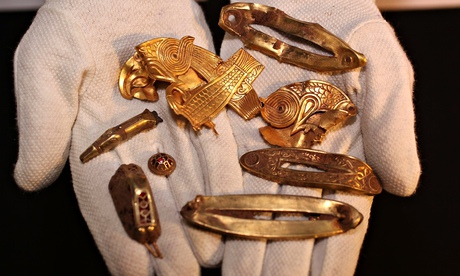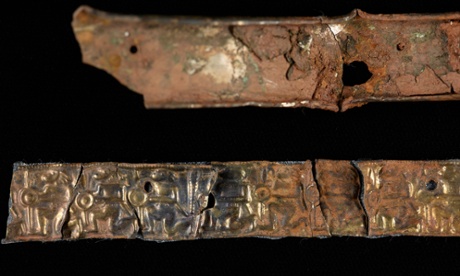All that glistered was not gold in Anglo-Saxon Mercia, or at least not the glowing pure gold which the warriors and princes coveted as arm rings and ornaments for their helmets and swords.
Research on the Staffordshire hoard, the largest hoard of precious metal from the period ever found, has revealed that their craftsmen had a cunning plan, a secret technique which gave lower grade metal with a high silver content the appearance of pure gleaming gold.
The technique was not written down in Anglo-Saxon times, and had never been detected in metalwork from the period, but a similar technique was known from Roman accounts. It must have been spoken about by the brilliant Anglo-Saxon metal workers, and involved taking gold which was alloyed with up to 25% silver, and heating it in an acid solution – made from iron rich minerals such as brick dust – so that at the surface the silver leached out and could be burnished off. The surface would then appear to be the highest quality gold, but just below the surface there was inferior metal.
“They knew what they were doing,” said Eleanor Blakelock, the scientist who discovered their secret. “This wasn’t something which could possibly have happened by accident.”
Blakelock made minute scrapes in the surface of the objects – so tiny that when she took a break she later had difficulty finding her mark on one piece – and then scanned them through an electron microscope, revealing the truth beneath the surface missed by other tests.
She found the technique was sometimes used aesthetically to change the colour of the surface and create contrasting decoration.
However she and the experts at Birmingham Museum, which has created a major gallery opening on Friday to show off the hoard, believe it must usually have been done to pass off lower quality gold. One particularly stunning set of gold and garnet hilt ornaments for a sceax, a long dagger, has one presumably later replacement part – the only one which showed the technique.
Blakelock’s initial tests on pieces from other collections suggests that it was more common on pieces made for women, but not used on the highest status pieces: it was apparently fine for a woman’s brooches, but not for a king’s arm rings.
The hoard was found in 2009 by metal detectorist Terry Herbert, scattered just below the surface of a field at Hammerwich. With more than 3,500 pieces, and another 90 found later in the same field, it is unique not just for its beauty but its composition. There is no women’s jewellery - it consists almost entirely of what archaeologist Chris Fern called “warrior bling”, sword, shield and helmet mounts - and was nearly all gold, more than six kilos with a small amount of silver. The pieces are almost all broken and twisted, wrenched from their original mounts, and assumed to be booty. The original hoard was bought by Birmingham and Stoke-on-Trent museums for £3.3m with a substantial grant from the National Heritage Memorial Fund and donations from all over the world.
Blakelocks’s research, funded by English Heritage, has fascinated and startled curators of other collections. She worked at the British Museum and tested pieces from some other finds including the most famous of all Anglo Saxon metalwork, the stunning pieces from the Sutton Hoo ship burial - and again found evidence of the same technique.
“The pieces are no less beautiful for this discovery,” David Symons, curator of archaeology at Birmingham, said, “but it’s fascinating to learn just how clever these guys were.”
• Birmingham Museum & Art Gallery, new Staffordshire Hoard Gallery, free from 17 October









